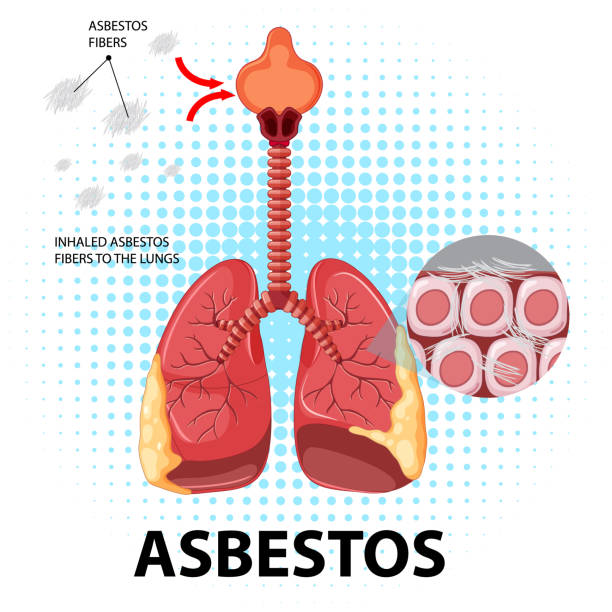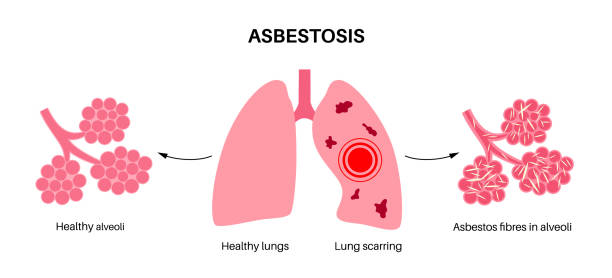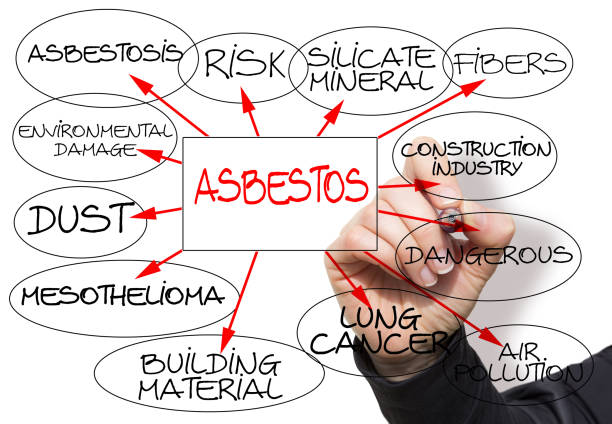When these fibers are inhaled, they can become lodged in the lung tissues, leading to inflammation and scarring (pulmonary fibrosis). Over time, this scarring can become extensive, impairing the elasticity of the lung tissue and making it difficult for the lungs to expand and contract normally.
This progressive lung damage results in difficulty breathing and reduced oxygen exchange, marking the onset of asbestosis.
Initial Exposure to Asbestos Dust

The primary mechanism of asbestos exposure leading to asbestosis is inhaling asbestos fibers. When materials containing asbestos are disturbed, microscopic fibers are released into the air and can be inhaled into the lungs.
The types of asbestos fibers most likely to cause asbestosis are long, thin amphibole fibers, such as crocidolite and amosite, which can penetrate deep into the lungs and remain lodged in the lung tissue.
These fibers are particularly harmful because their size and shape allow them to more easily evade the lungs’ natural cleaning processes, leading to persistent irritation and scarring (fibrosis) of lung tissue.
The Start of Inflammatory Response

Once lodged, these fibers provoke an immune response, where immune cells attempt to engulf and dissolve the fibers but fail due to the fibers’ resistance to breakdown.
This unsuccessful clearance leads to persistent activation of these immune cells, releasing inflammatory mediators and attracting more immune cells to the site.
This ongoing inflammatory process results in chronic inflammation and stimulates the proliferation of fibroblasts, cells that produce fibrous scar tissue, leading to the fibrosis characteristic of asbestosis.
This fibrotic reaction reduces pulmonary elasticity and gas exchange efficiency, progressively impairing lung function.
How Long Does Asbestosis Take To Develop?

Asbestosis typically takes a long time to develop, often appearing after 10 to 40 years following initial asbestos exposure.
The latency period—the time between exposure and the onset of symptoms—varies based on factors such as the intensity and duration of asbestos exposure, the type of asbestos fibers inhaled, and an individual’s overall health and genetic factors.
Asbestosis symptoms usually manifest once significant lung damage has occurred, making early detection difficult without specific medical surveillance.
How Is Asbestosis Diagnosed

Asbestosis is diagnosed through a combination of patient history, physical examination, and medical imaging.
First, a detailed history of occupational asbestos exposure is essential. During the physical exam, doctors listen for specific crackling sounds in the lungs when the patient breathes.
Diagnostic imaging, such as chest X-rays or high-resolution CT scans, is crucial as they can reveal irregularities and scarring in the lung tissue characteristic of asbestosis.
lung function tests are also used to assess how well the lungs are working by measuring the volume and speed of air that can be inhaled and exhaled.
In some cases, a lung biopsy may be performed to confirm the diagnosis by directly observing asbestos fibers in the lung tissue under a microscope.
In Summary
Understanding how asbestosis initiates is important in both prevention and early intervention.
From the initial inhalation of asbestos fibers to the onset of inflammatory responses in lung tissue, recognizing the early signs and symptoms is crucial for timely diagnosis and management.

